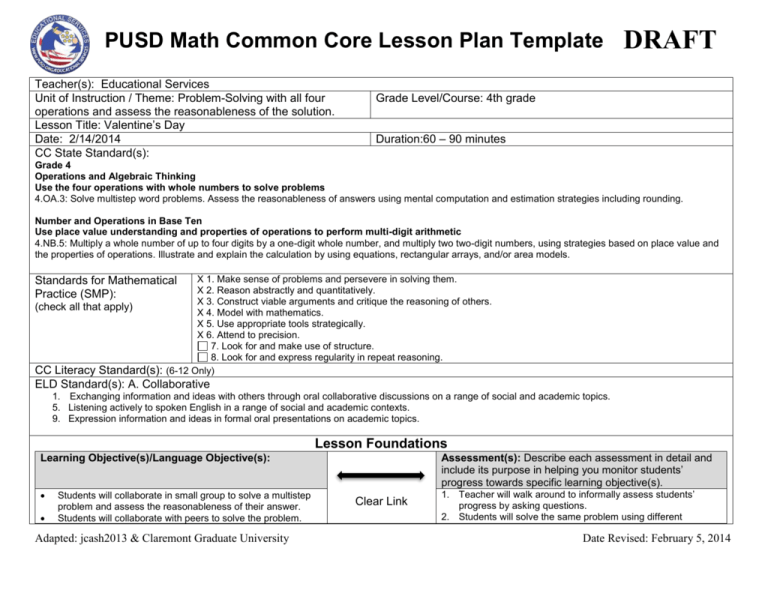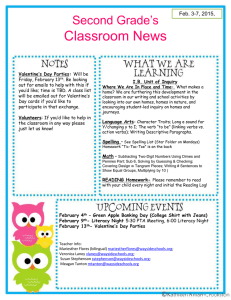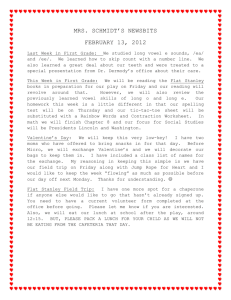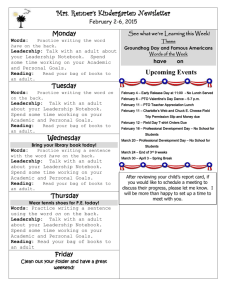4th grade Math lesson
advertisement

PUSD Math Common Core Lesson Plan Template Teacher(s): Educational Services Unit of Instruction / Theme: Problem-Solving with all four operations and assess the reasonableness of the solution. Lesson Title: Valentine’s Day Date: 2/14/2014 CC State Standard(s): DRAFT Grade Level/Course: 4th grade Duration:60 – 90 minutes Grade 4 Operations and Algebraic Thinking Use the four operations with whole numbers to solve problems 4.OA.3: Solve multistep word problems. Assess the reasonableness of answers using mental computation and estimation strategies including rounding. Number and Operations in Base Ten Use place value understanding and properties of operations to perform multi-digit arithmetic 4.NB.5: Multiply a whole number of up to four digits by a one-digit whole number, and multiply two two-digit numbers, using strategies based on place value and the properties of operations. Illustrate and explain the calculation by using equations, rectangular arrays, and/or area models. X 1. Make sense of problems and persevere in solving them. X 2. Reason abstractly and quantitatively. X 3. Construct viable arguments and critique the reasoning of others. X 4. Model with mathematics. X 5. Use appropriate tools strategically. X 6. Attend to precision. 7. Look for and make use of structure. 8. Look for and express regularity in repeat reasoning. (6-12 Only) Standards for Mathematical Practice (SMP): (check all that apply) CC Literacy Standard(s): ELD Standard(s): A. Collaborative 1. Exchanging information and ideas with others through oral collaborative discussions on a range of social and academic topics. 5. Listening actively to spoken English in a range of social and academic contexts. 9. Expression information and ideas in formal oral presentations on academic topics. Lesson Foundations Learning Objective(s)/Language Objective(s): Students will collaborate in small group to solve a multistep problem and assess the reasonableness of their answer. Students will collaborate with peers to solve the problem. Adapted: jcash2013 & Claremont Graduate University Assessment(s): Describe each assessment in detail and include its purpose in helping you monitor students’ progress towards specific learning objective(s). Clear Link 1. Teacher will walk around to informally assess students’ progress by asking questions. 2. Students will solve the same problem using different Date Revised: February 5, 2014 strategies to explain the similarities and difference between these two strategies. Students will use clear and precise vocabulary/language. 3. Students will complete T.I.P.S. Teacher will guide student’s thinking process by asking questions. 4. Students will be able to describe orally and in writing how they solved the problem. Students will discuss the problem, share the strategies, explain their reasoning orally and in writing, and present their thinking and solution. Essential Question: How does understanding base-10 number system help us add and subtract? What happens to a digit when multiplied by 10? How can we ensure our answer is reasonable? How can we organize our work when solving a multi-step word problem? College and Career X Demonstrating independence Readiness Skills X Responding to varying demands of (check all that apply) audience, task, purpose, and discipline X Building strong content knowledge X Comprehending as well as critiquing Common Core Instructional Shifts (check all that apply) Focus strongly where the Standards focus Coherence: Think across grades, and link to major topics within grades X Rigor: Require fluency, application, and deep understanding Using technology & digital media strategically and capably Demonstrating understanding of other perspectives and cultures Proving point of view with evidence Teaching and Learning As you plan and write your lesson, use the following guiding questions to support the implementation of the skills, 4Cs, and rigor. How are the identified Common Core and Readiness Skills embedded in the lesson? Which of the FOUR C’s will be engaged during this lesson? (check all that apply) X Communication X Collaboration Creativity X Critical Thinking How is academic RIGOR demonstrated in this lesson through the DOK? Depth of Knowledge (DOK) Level(s): (check all that apply) Level 1: Recall X Level 2: Skill/Concept X Level 3: Strategic Thinking Level 4: Extended Lesson Opener (Sharing objective(s) and Engaging/Motivating Students): Describe in detail how you will communicate learning objective(s). How will you purposefully engage students so they are either excited to learn “x” or feeling like “x” is important, worthwhile, and/or relevant? How will you access prior knowledge? How will you teach vocabulary (if applicable)? How will you check for understanding? Time Allocation 5 minutes Engaging/Motivating Students: (anticipation) Show pictures of candy hearts and Valentine’s day. What Teacher Does Ask students following questions: Why do you like to celebrate Valentine’s Adapted: jcash2013 & Claremont Graduate University What Students Do Students will share their experience or expectation on Valentine’s Day with partners. Differentiation RTI (Benchmark, Strategic, Intensive) ELD (Emerging, Expanding, bridging) Project images of cards for Valentine’s Day and Candy hearts. Provide sentence frames to EL and struggling students: Date Revised: February 5, 2014 Day? What is one special thing about Valentine’s Day? How did you celebrate Valentine’s Day? What is the significance of Valentine’s Day? Objective Sharing: Introduce the task to students by explaining the following: I like to celebrate Valentine’s Day because _________________. I can tell one special thing about Valentine’s Day that is __________. My family (or I) ___________ to celebrate Valentine’s Day. The significance of Valentine’s Day is __________________. “Heart” is a symbol of love. On valentine’s Day we gave candy hearts to express our love to those around us. In this lesson you will help me figure out: “Do I have enough Candy Heart to give to all of you?”, “If I do, how many Candy Hearts will I have left after giving 12 pieces to all of you?”. After solving the problem, you also need to prove your answer is reasonable by using mental math or estimate. Instruction and Practice: Describe in detail your instructional approach (direct, discovery, inquiry, etc.). What will you do to present the content so it is comprehensible and purposefully designed to help students meet the learning objective(s)? What will you do for guided practice? What will you do for independent practice? Furthermore, how will you promote and monitor student engagement and check for understanding at all levels of instruction? How will you check for understanding? What questions will you ask to check for understanding? Time Allocation What Teacher Does Prior to problem solving: Anticipate student responses (solve problems with different strategies). Create a list of anticipated ways students may solve the problem. Use the chart below to record student thinking. Anticipated strategy Who Sequence did what? Visual/Pictures/Manipulatives Number Line Repeated Addition Area Model of Multiplication Distributive Property Making a table Adapted: jcash2013 & Claremont Graduate University What Students Do Before Problem-Solving: In a small group, share their experience on Valentine’ Day. Differentiation RTI (Benchmark, Strategic, Intensive) ELD (Emerging ,Expanding ,Bridging) Provide pictures of Valentine’s Day and Candy Hearts. Provide multiplicatives; such as: base-ten blocks for students to use. Read the questions with the teacher. Think about the question, underline the question, and copy the question. Think about the important information and circle it. Ask the following questions to facilitate the investigation to EL students and students who are struggling: “How many students are there? How many candies did each student receive?” “How many candies did Ms. Smith give to her students? How many did she buy? ” Date Revised: February 5, 2014 Other 5 minutes (Discuss the problem with students and checking for understanding) Before Problem-Solving: Pass the “Valentine’s Day” problem (it can be on T.I.P.S. form) to students: “On Valentine’s Day, Ms. Smith gave her 25 students 12 candy hearts each. If she had 3 boxes of 120 candy hearts each. How many candy hearts did she have left?” Read/discuss the problem with students; including : “What is the question?” and “Identify the important information” CFU: “What is the question?” and “Identify the important information” 20-25 minutes (students work on task with peers) During Problem-Solving: Arrange students in pre-selected small group. Walk around the classroom to observe how students approach the problem. Ask the following questions to facilitate the investigation to individual or small group of students: “How many students are there? How many candies did each student receive?” “How many candies did Ms. Smith give to her students? How many did she buy? ” “What do you have to find out first? How could you do to figure this out?” “What number can you start with for this problem?” “How did you figure out the answer?” “Why do you think the answer is correct/reasonable?” “Is there any way to solve this problem?” During Problem-Solving: Explore the strategies to find the solution for this problem. “What do you have to find out first? How could you do to figure this out?” “What number can you start with for this problem?” “How did you figure out the answer?” “Why do you think the answer is correct/reasonable?” “Is there any way to solve this problem?” Provide sentence frames for EL students: First, I ___________ because_________________________. After that, I _______________ because_______________________. Then, I __________________ because_________________________. Finally, I _________________ (because)_________________________. Explain to each other their strategies and record the strategies they will use to solve this problem. Share the solution orally with peers and justify how they know their answer is correct. Monitor students by asking students to clarify their thinking and record which students are using which strategies. Adapted: jcash2013 & Claremont Graduate University Date Revised: February 5, 2014 Choose which strategies should be shared and in what order. 15-20 minutes (students present their solutions) After Problem-Solving: Ask students who are presenting and students in the audience checking for understanding questions. After the second student presents the teacher will also ask students to make connections between each of the strategies presented. Perhaps by comparing and contrasting. The teacher will continue to help students make the connections between each strategy presented. After Problem-Solving: Students will share their solution orally or listen to their peers sharing their solutions. Students will answer questions posed by other students and the teacher. Note: If none of the students use the Area Model for multiplication or the Distributive Property to solve the problem, teachers will reteach these strategies using the same problem. Closure: Describe in detail how you will know if lesson objective(s) are met? How will students reflect on their learning? How will you connect learning to real world experience? Time Differentiation What Teacher Does What Students Do RTI (Benchmark, Strategic, Intensive) Allocation ELD (Emerging, Expanding, Bridging) Students will justify the reasonableness Provide students with multiplicatives; 10-15 Pose the questions to students: of their answer using estimate such as base-ten blocks “Why do you think the answer is correct/reasonable? minutes strategies; such as rounding the numbers to the nearest tens or hundreds. Identify vocabulary that will need to be introduced or reviewed: Materials and resources needed for lesson: Tier 1 Words: Tier 2 Words: Provide number line for students so assist them with rounding. Tier 3 Words: Multiply, multiplication Subtract, subtraction, Distribution property, Area Model of Multiplication Number line Paper, pencils or pens, number line, base-ten blocks, pictures of Valentine’s Day and candy hearts Valentine's Day Candy hearts Left Adapted: jcash2013 & Claremont Graduate University Explain ,justify, diagram, organize, table, reasonableness Date Revised: February 5, 2014







